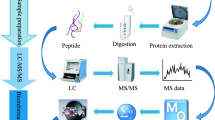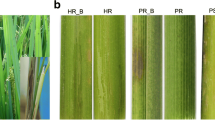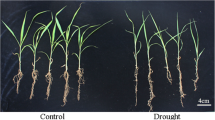Abstract
Heterosis had been increasingly applied in crop production for nearly a century, but the molecular basis of it was poorly understood especially in foxtail millet (Setaria italica). Zhangzagu10 which derived from two-line hybrid breeding system has the characters of ultra-high yield, good stability and extensive disease and lodging resistance. To gain a better understanding of the molecular basis of S.italica heterosis, the isobaric tags for relative and absolute quantification based quantitative proteomic analyses was performed between S.italica hybrid Zhangzagu10 and it parents (male parent Zhangzagu10fu and female parent A2). A total of 4015 proteins were detected, among which 610/276 differentially expressed proteins (DEPs) between Zhangzagu10 and the female/male parent, respectively. The cluster analysis showed that the DEPs expression profiles of Zhangzagu10 were closer to those of the male parent. GO functional classification divided the DEPs into three functional categories (Cellular component, Biological process and Molecular function) and 26 subfamilies, among which three subfamilies had 100% difference between Zhangzagu10 and its parents. KEGG metabolic pathway exhibited significant enrichment of DEPs in Metabolic pathways, Carbon fixation in photosynthetic organisms and Photosynthesis. qRT-PCR verification confirmed the differential expression data and revealed that the expression level of 3 selected genes (such as peroxidase 5-like,G-type lectin S-receptor-like serine/threonine-protein kinase SD2-5,two-on-two hemoglobin-3, etc.) was higher in Zhangzagu10 than that in its male parent. The expression level of 7 selected genes (such as peroxidase 64-like, cysteine-rich receptor-like protein kinase 45, indole-3-acetaldehyde oxidase, etc.) was higher in Zhangzagu10 than that in its male parent, but significantly lower than that in A2. Thus, A2 can potentially optimise the agricultural qualities of Zhangzagu10. Taken together, we hope that this study provides valuable information for the further utilisation and study on the molecular mechanisms of heterosis in hybrid millet.







Similar content being viewed by others
Abbreviations
- DEPs:
-
Differentially expressed proteins
- S. italica :
-
Setaria italica
- iTRAQ:
-
Isobaric tags for relative and absolute quantification
- GO:
-
Gene ontology
- KEGG:
-
Kyoto encyclopedia of genes and genomes
- qRT-PCR:
-
Quantitative real-time polymerase chain reaction
- MS:
-
Mass spectrometry
- PVPP:
-
Polyvinylpolypyrrolidone
- TCA:
-
Trichloroacetic acid
- PMSF:
-
Phenylmethanesulfonyl fluoride
- HEPES:
-
4-(2-hydroxyethyl)-1-piperazine ethanesulfonic acid
- EDTA:
-
Ethylene diamine tetraacetic acid
- DTT:
-
Dithiothreitol
- IAM:
-
Iodoacetamide
- TEAB:
-
Tetraethylammonium bicarbonate
- SDS:
-
Sodium dodecyl sulphate
- HPLC:
-
High performance liquid chromatography
- ACN:
-
Acetonitrile
- DEPC:
-
Diethy pyrocarbonate
References
Bennetzen JL, Schmutz J, Hao W, Percifield R, Hawkins J, Pontaroli AC, Estep M, Feng LF, Vaughn JN, Grimwood J, Jenkins J, Barry K, Lindquist E, Hellsten U, Deshpande S, Wang XW, Wu XM, Mitros T, Triplett J, Yang XH, Ye CY, Mauro-Herrera M, Wang L, Li PH, Sharma M, Sharma R, Ronald PC, Panaud O, Kellogg EA, Brutnell TP, Doust AN, Tuskan GA, Rokhsar D (2012) Reference genome sequence of the model plant Setaria. Nat Biotechnol 30(6):555–561
Briggle LW (1963) Heterosis in wheat—a review. Crop Sci 3:407–412
Bustos-Sanmamed P, Tovar-Mendez A, Crespi M, Sato S, Tabata S, Becana M (2011) Regulation of nonsymbiotic and truncated hemoglobin genes of Lotus japonicus in plant organs and in response to nitric oxide and hormones. New Phytol 189:765–776
Coors JG, Pandey S (1997) Proceedings of the international symposium on the genetics and exploitation of heterosis in crops. CIMMYT, pp 17–22
Gafken PR, Lampe PD (2006) Methodologies for characterizing phosphoproteins by mass spectrometry. Cell Commun Adhes 13(5–6):249–262
Guo M, Rupe MA, Zinselmeier C, Habben J, Bowen BA, Smith OS (2004) Allelic variation of gene expression in maize hybrids. Plant Cell 16:1707–1716
Gupta KJ, Fernie AR, Kaiser M, VanDongen JT (2011) On the origins of nitric oxide. Trends Plant Sci 16:160–168
Jin Z, Cai GL, Li XM, Gao F, Yang JJ, Lu J, Dong JJ (2014) Comparative proteomic analysis of green malts between barley (Hordeum vulgare) cultivars. Food Chem 151(20):266–270
Kim BH, Kim SY, Nam KH (2012) Genes encoding plant-specific class III peroxidases are responsible for increased cold tolerance of the brassinosteroid-insensitive 1 mutant. Mol Cells 34(6):539–548
Ma C, Zhou J, Chen G, Bian Y, Lv D, Li X, Wang Z, Yan Y (2014) iTRAQ-based quantitative proteome and phosphoprotein characterization reveals the central metabolism changes involved in wheat grain development. BMC Genom 15(1):1–20
Ma J, Chen T, Wu S, Yang C, Bai M, Shu K, Li K, Zhang G, Jin Z, He F, Hermjakob H, Zhu Y (2019) iProX: an integrated proteome resource. Nucleic Acids Res 47:D1211–D1217
Min L, Kunzheng C, Yuting C, Shiming L, Zhixing Z, Wenxiong L (2014) Proteomic analysis of silicon-mediated resistance to Magnaporthe oryzae in rice (Oryza sativa L.). Eur J Plant Pathol 139(3):579–592
Nagata M, Murakami E, Shimoda Y, Shimoda-Sasakura F, Kucho K, Suzuki A, Abe M, Higashi S, Uchiumi T (2008) Expression of a class1 hemoglobin gene and production of nitric oxide in response to symbiotic and pathogenic bacteria in Lotus japonicus. Mol Plant Microbe Interact 21:1175–1183
Pan JW, Li Z, Wang QG, Anna KG, Liu M, Guan YN, Zhou WQ, Liu W (2018) Comparative proteomic investigation of drought responses in foxtail millet. BMC Plant Biol 18:315
Passardi F, Cosio C, Penel C, Dunand C (2005) Peroxidases have more functions than a Swiss army knife. Plant Cell Rep 24(5):255–265
Peng YG, Wei G, Zhang L (2014) Comparative transcriptional profiling of three super-hybrid rice combinations. Int J Mol Sci 15(3):3799–3815
Sanchez C, Cabrera JJ, Gates AJ, Bedmar EJ, Richardson DJ, Delgado MJ (2011) Nitric oxide detoxification in the rhizobia- legume symbiosis. Biochem Soc Trans 39:184–188
Severino FE, Brandalise M, Costa CS, Wilcken SR, Maluf MP, Goncalves W, Maia IG (2012) CaPrx, a Coffea arabica gene encoding a putative class III peroxidase induced by root-knot nematode infection. Plant Sci 191–192:35–42
Song X, Ni ZF, Yao YY, Xie CJ, Li ZX, Wu HY, Zhang YH, Sun QX (2007) Wheat (Triticum aestivum L.) root proteome and differentially expressed root proteins between hybrid and parents. J Proteom 7:3538–3557
Sun XL, Yu QY, Tang LL, Ji W, Bai X, Cai H, Liu XF, Ding XD, Zhu YM (2013) GsSRK, a G-type lectin S-receptor-like serine/threonine protein kinase, is a positive regulator of plant tolerance to salt stress. J Plant Physiol 170(5):505–515
Valentim-Neto PA, Rossi GB, Anacleto KB, de Mello CS, Balsamo GM, Arisi AC (2016) Proteome comparison of two GM common bean varieties and their non-GM counterparts by principal component analysis. J Sci Food Agric 96(3):927–932
Wang CJ, Chan YL, Shien CH, Yeh KW (2015) Molecular characterization of fruit-specific class III peroxidase genes in tomato (Solanum lycopersicum). J Plant Physiol 177:83–92
Wiese S, Reidegeld KA, Meyer HE, Warscheid B (2007) Protein labeling by iTRAQ: a new tool for quantitative mass spectrometry in proteome research. The Proteom 7(3):340–350
Yao YY, Ni ZF, Zhang YH, Chen Y, Ding YH, Han ZF, Liu ZY, Sun QX (2005) Identification of differentially expressed genes in leaf and root between wheat hybrid and its parental inbreds using PCR-based cDNA subtraction. Plant Mol Biol 58:367–384
Ytterberg AJ, Peltier JB, Wijk KJ (2006) Protein profiling of plastoglobules in chloroplasts and chromoplasts. A surprising site for differential accumulation of metabolic enzymes. Plant Physiol 140(3):984–997
Zhang GY, Liu X, Quan ZW, Cheng SF, Xu X, Pan SK, Xie M, Zeng P, Yue Z, Wang WL, Tao Y, Bian C, Han CL, Xia QJ, Peng XH, Cao R, Yang XH, Zhan DL, Hu JC, Zhang YX, Li HN, Li H, Li N, Wang JY, Wang CC, Wang RY, Guo T, Cai YJ, Liu CZ, Xiang HT, Shi QX, Huang P, Chen QC, Li YR, Wang J, Zhao ZH, Wang J (2012) Genome sequence of foxtail millet (Setaria italica) provides insights into grass evolution and biofuel potential. Nat Biotechnol 30(6):549–554
Zieske LR (2006) A perspective on the use of iTRAQ reagent technology for protein complex and profiling studies. J Exp Bot 57(7):1501–1508
Acknowledgements
The mass spectrometry proteomics data have been deposited to the ProteomeXchange Consortium (http://proteomecentral.proteomexchange.org) via the iProX partner repository with the dataset identifier PXD017131. (Ma et al. 2019). This research was funded by Major national science and technology projects (2014ZX0800909B), Selection and training of talents of higher discipline plan of Hebei Province (BR2-234), Hebei Province Natural Science Fund (C2018405042); Key R & D projects of Hebei Province (19226420D); Hebei Province Science and Technology Support Program under grant number 13226326; Major Projects Foundation of Hebei North University (ZD201407) and Major Projects Foundation of Hebei North University (ZD201305).
Author information
Authors and Affiliations
Corresponding author
Ethics declarations
Conflict of interest
No potential conflict of interest was reported by the authors.
Additional information
Publisher's Note
Springer Nature remains neutral with regard to jurisdictional claims in published maps and institutional affiliations.
Rights and permissions
About this article
Cite this article
Weng, Q., Song, X., Zhao, Y. et al. Proteomic profiling of foxtail millet hybrid Zhangzagu10 and its parent lines using iTRAQ-based technique. J. Plant Biochem. Biotechnol. 29, 439–449 (2020). https://doi.org/10.1007/s13562-020-00551-2
Received:
Accepted:
Published:
Issue Date:
DOI: https://doi.org/10.1007/s13562-020-00551-2




